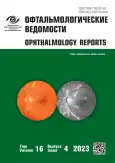Comparative characteristics of ophthalmological symptoms of orbitocranial and orbital cavernous venous malformation
- Authors: Serova N.K.1, Trunova A.P.1, Grigorieva N.N.1, Lasunin N.V.1
-
Affiliations:
- N.N. Burdenko National Scientific and Practical Center for Neurosurgery
- Issue: Vol 16, No 4 (2023)
- Pages: 35-42
- Section: Original study articles
- URL: https://journals.rcsi.science/ov/article/view/254571
- DOI: https://doi.org/10.17816/OV568972
- ID: 254571
Cite item
Abstract
BACKGROUND: Cavernous venous malformation of the orbit, formerly known as cavernous hemangioma of the orbit, refers to vascular malformations with slow blood flow, and is a frequent lesion of the orbit in adults. The spread of cavernous venous malformation of the orbit into the cranial cavity is extremely rare.
AIM: The aim of this study is a comparative analysis of ophthalmological manifestations of orbitocranial and orbital cavernous venous malformation.
MATERIALS AND METHODS: The analysis was performed on 50 patients operated in N.N. Burdenko National Scientific and Practical Center for Neurosurgery from 2004 till 2023. Two groups of patients with сavernous venous malformation of the orbit were identified: group 1 — with malformation spreading into the cranial cavity, group 2 —with malformation localized in the orbit only.
RESULTS: In 29 patients, cavernous venous malformation of the orbit spread into the cranial cavity through superior orbital fissure, inferior orbital fissure, optic canal and/or through combinations thereof; in 21 patients, the malformation was located in the orbit only. Females prevailed in both groups; the average age was 44 years. The first group included patients with the following features: visual impairments were more frequent and more prominent, oculomotor disorders caused mainly by the involvement of oculomotor and abducens nerves; optic nerve atrophy, slight proptosis. The second group was identified by more prominent proptosis, more mild visual impairments, oculomotor disorders caused by the presence of the malformation in the orbit, at the eye fundus, optic nerve head edema prevailed.
CONCLUSIONS: Ophthalmic symptoms due to topographic and anatomical variants of a cavernous malformation.
Full Text
##article.viewOnOriginalSite##About the authors
Natalya K. Serova
N.N. Burdenko National Scientific and Practical Center for Neurosurgery
Email: nserova@nsi.ru
ORCID iD: 0000-0003-0148-7298
SPIN-code: 5079-8064
MD, Dr. Sci. (Medicine), Professor, RAEN Сorrespondent Member
Russian Federation, MoscowAnna P. Trunova
N.N. Burdenko National Scientific and Practical Center for Neurosurgery
Email: sergeevann94@mail.ru
ORCID iD: 0000-0003-1890-7201
SPIN-code: 5190-1062
Russian Federation, 16 4-ya Tverskaya-Yamskaya st., Moscow, 125047
Nadezhda N. Grigorieva
N.N. Burdenko National Scientific and Practical Center for Neurosurgery
Email: NGrigoreva@nsi.ru
ORCID iD: 0000-0001-8411-5152
MD, Cand. Sci. (Medicine)
Russian Federation, MoscowNikolay V. Lasunin
N.N. Burdenko National Scientific and Practical Center for Neurosurgery
Author for correspondence.
Email: NLasunin@nsi.ru
ORCID iD: 0000-0002-6169-4929
SPIN-code: 8468-8449
MD, Cand. Sci. (Medicine)
Russian Federation, MoscowReferences
- Calandriello L, Grimaldi G, Petrone G, et al. Cavernous venous malformation (cavernous hemangioma) of the orbit: current concepts and a review of the literature. Surv Ophthalmol. 2017;62(4):393–403. doi: 10.1016/j.survophthal.2017.01.004
- Brovkina AF, Astakhov YuS. Manual on clinical ophthalmology. Moscow: Medical Informative Agency. 2014. 796 p. (In Russ.)
- Harris GJ, Jakobiec FA. Cavernous hemangioma of the orbit. J Neurosurg. 1979;51(2):219–228. doi: 10.3171/jns.1979.51.2.0219
- Yan J, Wu Z. Cavernous hemangioma of the orbit: analysis of 214 cases. Orbit. 2004;23(1):33–40. doi: 10.1076/orbi.23.1.33.28992
- Ansari SA, Mafee MF. Orbital cavernous hemangioma: role of imaging. Neuroimag Clin. 2005;15(1):137–158. doi: 10.1016/j.nic.2005.02.009
- Cophignon J, d’Hermies F, Civit T. Tumeurs vasculaires de l’orbite. Neurochirurgie. 2010;56(2–3):197–212. doi: 10.1016/j.neuchi.2010.02.028 (In French)
- Dallan I, Locatelli D, Turri-Zanoni M, et al. Transorbital endoscopic assisted resection of a superior orbital fissure cavernous haemangioma: a technical case report. Eur Arch Oto-Rhino-L. 2015;272:3851–3856. doi: 10.1007/s00405-015-3556-2
- Chen Y, Tu Y, Chen B, et al. Endoscopic transnasal removal of cavernous hemangiomas of the optic canal. Am J Ophthalmol. 2017;173:1–6. doi: 10.1016/j.ajo.2016.09.022
- Young SM, Kim KH, Kim Y-D, et al. Orbital apex venous cavernous malformation with optic neuropathy: treatment with multisession gamma knife radiosurgery. Br J Ophthalmol. 2019;103(10): 1453–1459. doi: 10.1136/bjophthalmol-2018-312893
- Algoet M, Van Dyck-Lippens P, Casselman J, et al. Intracanal optic nerve cavernous hemangioma: a case report and review of the literature. World Neurosurg. 2019;126:428–433. doi: 10.1016/j.wneu.2019.02.202
- Sullivan TJ. Vascular anomalies of the orbit — a reappraisal. Asia Pac J Ophthalmol. 2018;7(5):356–363. doi: 10.22608/apo.2017151
- Henderson JW. Vascular hamartomas, hyperplasias, and neoplasms. In: Henderson JW, editor. Orbital tumors. 3rd edition. New York: Raven Press, 1994. P. 95–100.
- Suri A, Ahmad FU, Mahapatra AK. Extradural transcavernous approach to cavernous sinus hemangiomas. Neurosurgery. 2007;60(3):483–489. doi: 10.1227/01.neu.0000255333.95532.13
- Paonessa A, Limbucci N, Gallucci M. Are bilateral cavernous hemangiomas of the orbit rare entities? The role of MRI in a retrospective study. Eur J Radiol. 2008;66(2):282–286. doi: 10.1016/j.ejrad.2007.06.002
- Hsu C-H, Hsu W-M. Cavernous hemangioma of the orbit: 42 patients. J Exp Clin Med. 2011;3(6):278–282. doi: 10.1016/j.jecm.2011.10.010
- Scheuerle AF, Steiner HH, Kolling G, et al. Treatment and long-term outcome of patients with orbital cavernomas. Am J Ophthalmol. 2004;138(2):237–244. doi: 10.1016/j.ajo.2004.03.011
- Osguthorpe JD, Saunders RA, Adkins WY. Evaluation of and access to posterior orbital tumors. The Laryngoscope. 1983;93(6): 766–71. doi: 10.1288/00005537-198306000-00013
Supplementary files











